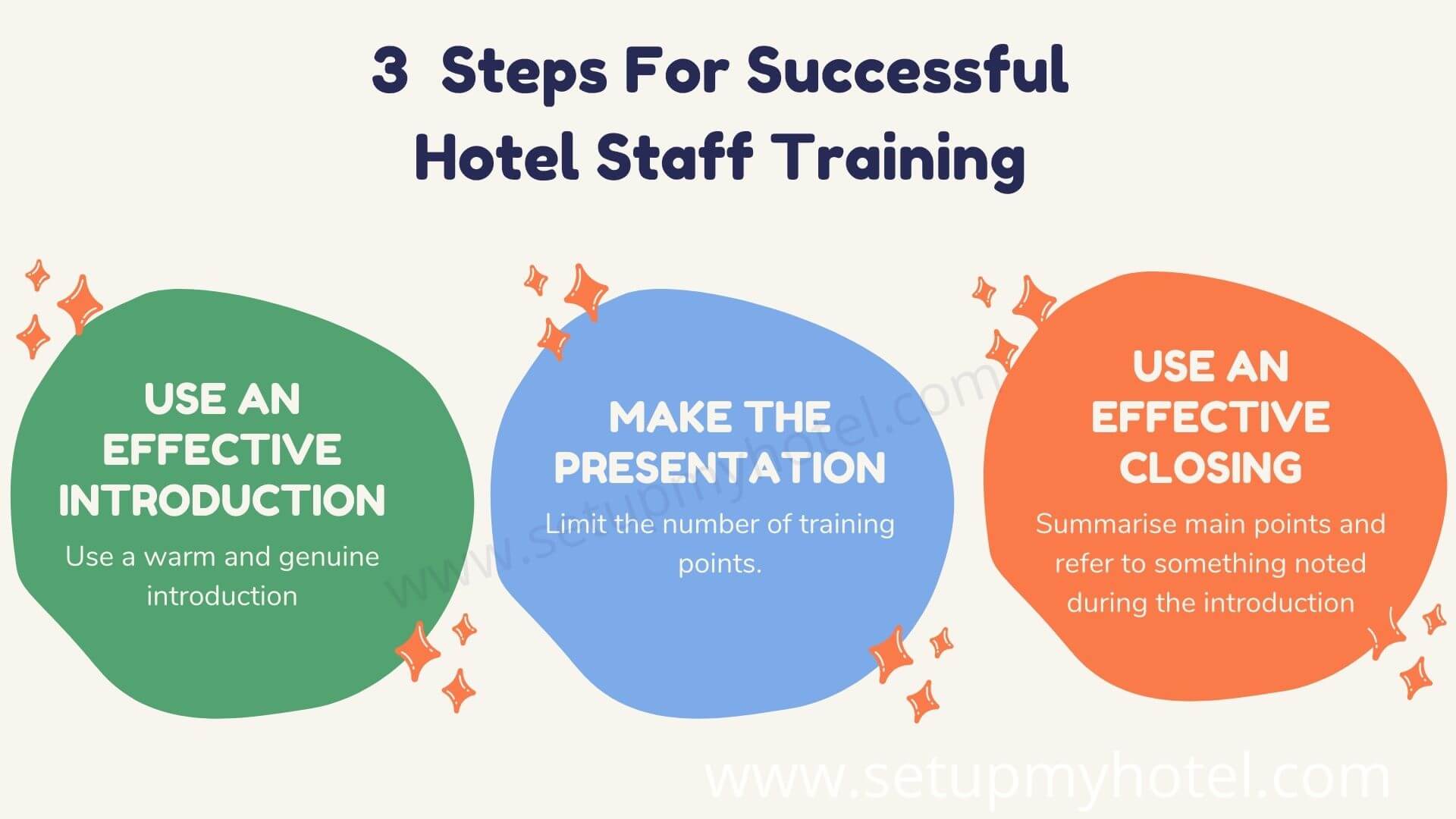📘 Hotel SOP Download
“Comprehensive SOPs for all departments – Front Office, Housekeeping, F&B, Finance, Engineering & more.”
👉 Download Now & Streamline Your Operations
Download SOP
Three Main Steps For Successful Hotel Staff Training
HotelA Hotel or Inn may be defined as an establishment whose primary business is providing lodging facili... Staff Trainer Presentation:
- Many group trainers are excellent public speakers who can keep their trainees attention.
- One does not need to be a professional speaker to be an effective group trainer.
- What is required is a planned, organized, and practiced approach to training delivery that avoids common public speaking mistakes.
- Trainers who have this foundation of public speaking skills will likely deliver an effective training session.
Step 1: Use an Effective Introduction
- Training should begin with an introduction.
- Use a warm and genuine introduction. If necessary, the trainer should introduce him or herself and allow the trainees to introduce themselves.
- The introduction should focus on what’s in it from the perspective of the trainees.
- The training session can be previewed. Training goals can be noted, and trainees can be informed about training tactics.
- Establish training requirements, including those about restroom and coffee breaks, mobile/cell phone usage, trainee participation, and related issues.
- If applicable, use an icebreaker to help trainees transition into the session.
- Indicate whether questions should be asked when they arise during the session or whether they should be held for discussion at its end.
- Gain the trainees ’ attention. Ask for trainee anecdotes or tell one ’ ‘s own stories about situations related to the training topic.
- A note about humor: many trainers begin a training session by telling a humorous story.
- This can gain the trainees ’ attention, transition them from the workplace to the training, and provide a subconscious message that the training will be enjoyable.
- However, inappropriate humor can hinder the training, and many topics that were socially acceptable in the past are inappropriate today.
- In a workplace that is becoming more culturally diverse, it is increasingly difficult to anticipate how a humorous story will be viewed by all of the trainees.
Step 2: Make the Presentation
- Limit the number of training points. This is easy when an effectively developed training lesson provides the presentation outline.
- Discuss topics in the same sequence as they are noted in the introduction.
- Use transitions between main points (e.g., “ Now that you know how to assemble the equipment, let ’ ‘s learn how to safely operate it. ” ).
- Conclude each main point with a summary (e.g., “ To this point, you have learned that the equipment must be operated according to the manufacturer’s instructions. Now let ’ ‘s learn how to use it for some specialty items. ” ).
- Manage questions effectively.
- Suggestions include repeating the question, providing a response, or asking other trainees to provide a suggested response.
- Be aware of nonverbal communication.
- Body language can frequently tell the trainees more than the trainer can say.
- Facial expressions can suggest that the trainer is frustrated with the trainees ’ inability to learn, or pacing back and forth may suggest that the trainer is bored.
- Use an outline to stay organized. A well-developed training lesson is, in part, an outline of the training points.
- Experienced trainers keep trainees tuned in to the session by providing methods for their active involvement and by asking open-ended questions of all trainees (not just of those who volunteer).
- They speak at the appropriate volume and pace.
- Trainers should avoid slang terms and jargon that hinder communication effectiveness.
- This is frequently a challenge because of the diverse group of employees in many organizations. Effective trainers pronounce words correctly, change voice tones, and avoid public speaking errors such as the frequent use of stalling expressions (e.g., “ you know, ” “ let ’ s see, ” “ah, ” and “ like, you know”).
Step 3: Use an Effective Closing
- Summarise the main points and refer to something noted during the introduction: “ When we began the training, I indicated that you would learn how to safely operate the equipment.”
- It should also involve a call to action about what the trainees should do: “ Now that you ’ ‘ve learned how to safely operate the equipment, please do so all the time. The right way is the safe way, and there should be no compromise in this standard. ”
- Group training will not automatically be effective if the trainer is a good public speaker, but training cannot be effective if the trainer is not a good communicator.
- Fortunately, this skill can be enhanced through experience and when the trainer has an interest in improving communication skills.
- Effective trainers must be good communicators. This is important when an on-the-job training method is used, but it is especially critical for group training. Trainers have fewer opportunities to solicit feedback and to determine whether training content is understood.
📘 Hotel SOP Download
“Comprehensive SOPs for all departments – Front Office, Housekeeping, F&B, Finance, Engineering & more.”
👉 Download Now & Streamline Your Operations
Download SOP
Back Office Job Description
Banquet
BAR
Beverage Service
Cashiering
Chef
Chef Training
Cleaning
Concierge
Duties and Responsibility
Engineering
Executive Chef
F&B Setup
F&B Training
Finance
Food Service
Front Desk
Front Office Formats
Front Office Setup
Front Office Training
Guest Room
Guest Services
Hospitality Basics
Hotel Formats
Hotel Security
Hotel Staff Job Description
Hotel Staff Training
Housekeeping Formats
Housekeeping Setup
Housekeeping Training
Kitchen
Kitchen Basics
Kitchen Training
Maintenance
Maintenance Technician
Reservation
Restaurant
Sales
SOP
SOP F&B Service
SOP Finance and Accounting
SOP Front Office
SOP Housekeeping
SOP Kitchen
Staff Training











